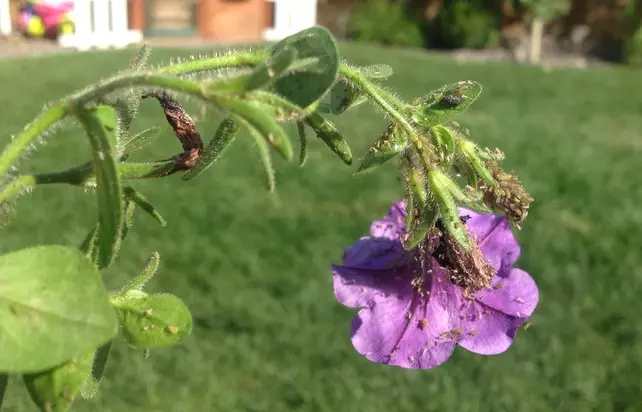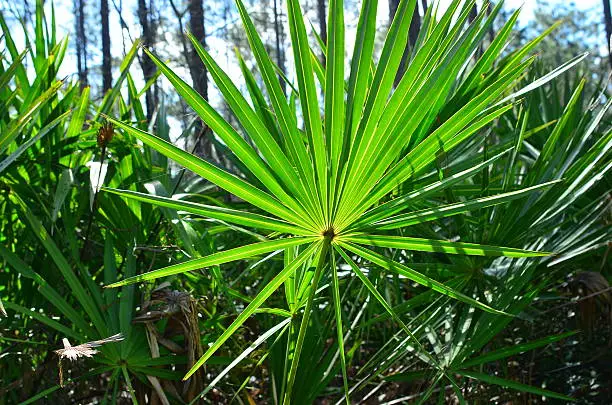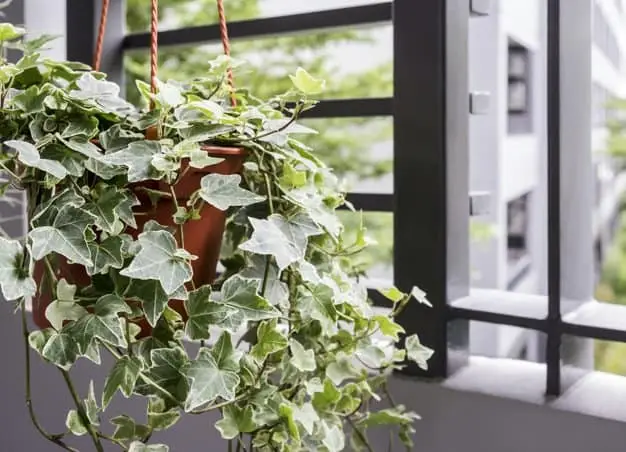Root rot is a common disease affecting indoor potted plants. A bird of paradise plant suffering from root rot can die if untreated. But, what are the causes, and how do you identify and treat root rot in strelitzia plants?
Soggy soils from constant overwatering and poorly-draining potting mix are the main causes of root rot. The disease makes the infested leaves turn yellow, brown at the tips, wilt, and droop. The plant grows slowly and eventually dies. Removing the damaged parts and repotting the good ones will treat root rot.
What causes root rot in bird of paradise plants?
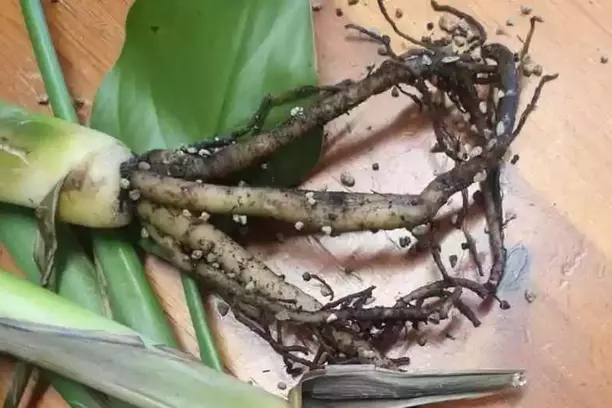
Overwatering, poor drainage, and conditions leading to soggy soils are causes of root rot in bird of paradise plants.
Here are the main reasons for root rot disease in strelitzia plants:
Constant overwatering
Bird of paradise prefers moist soils to thrive. Soggy or overly wet from excess rain or excess irrigation encourages root rot.
A Strelitzia plant requires oxygen and nutrients to survive. However, soggy soil from overwatering prevents it from absorbing these essential growth elements. Furthermore, over-irrigation allows mold, fungi, and bacteria to thrive, leading to root rot.
Check the top 2-3 inches of your pot mix to confirm if it is soggy by dipping your fingers into the pot. If constantly wet, the root rot disease of your bird of paradise is from constant overwatering.
Waterlogged soils
Poor drainage is another reason for the root rotting of your bird of paradise plant. Soils with poor drainage hold more water, making the soil soggy, thus encouraging root rot.
There are three leading causes of waterlogging in potted strelitzia plants.
- If your pots don’t have sufficient holes
- If your pots have no holes at all
- Poorly drained potting mix.
A container without holes or fewer openings underneath encourages water pooling after irrigation. The potting mix becomes soggy and hardens, preventing the roots from absorbing nutrients and oxygen. Hence, it favors root rot on potted birds of paradise plants.
Waterlogging also results from a potting mix with poor drainage. The mix holds more water than needed and doesn’t allow the excess to flow out of the pot. Water pooling makes the soil overly wet, encouraging root rot.
Planting the strelitzia plant in an oversize container
Pot size is a vital factor that influences how the plant develops when planted indoors. Choosing the wrong container causes problems that may lead to diseases such as root rot.
Large containers with sparsely spaced Strelitzia plants cause issues related to soggy soils when irrigating plants. Most of the water remains unused, making the mix soggy. Afterward, the soggy conditions favor root rot, fungi, and bacteria infestation.
The pot should be medium-sized. A good size is up to three inches wider than the plant to prevent water from collecting on the parts.
Watering the plant heavily when it’s dormant
Cold temperatures, especially in winter, make the bird of paradise plant less active or dormant. Dormant plants have a slower physiological rate and don’t need much water.
Watering a dormant strelitzia plant might cause root rot. Regular irrigation gives the plant water it doesn’t need. Thus, most of it will remain in the mix. Excess water sogs the soil, causing root rot.
Cold drafts and low temperatures
Since the bird of paradise is a subtropical plant, it prefers warmer, humid locations. Its favorable temperatures are between 65oF and 85oF. Temperatures below 50oF increase the possibility of root rot in the plant.
Low temperatures interfere with the plant’s water absorption, making the soil soggy and encouraging root rot. Similarly, cold drafts, especially in winter, freeze the plant and prevent it from absorbing water properly. Therefore, the soil often remains wet, encouraging root rot.
Fungi
Fungi are also a common cause of root rot in bird of paradise plants. They usually come into the plant from other plants nearby or on wet soils. Furthermore, previously fungi-infected soils can cause root rot in the Strelitzia plant.
Signs of root rot
Root rot in the bird of paradise starts from the roots – where you cannot easily identify it – and spreads to the other parts. Specific changes in the parts of the plant’s color and orientation can indicate root rot.
Yellowing leaves
The first sign confirming root rot is yellowing leaves. However, yellow leaves can signify other problems such as lack of nutrients, heat stress, or poor pH.
The leaves turn yellow from the foliages below and gradually spread upwards. If the yellow leaves are more than sixty percent, your strelitzia plant has root rot.
Yellowing is followed by wilting, drooping, then death.
Brown leaf tips
The leaves of the root rotting bird of paradise also turn brown at the tips as the disease progresses. The edges also become brown.
Discolored, soft, smushy, and curled stem
A healthy bird of paradise has firm, upright stems. However, the stems appear black or brown and twist downwards if infected with root rot.
They also feel soft and smushy when touched.
Stunted growth
A strelitzia plant suffering from root rot grows slowly or stops growing. Stunted growth results from the plant’s inability to absorb the water, nutrients, and oxygen it needs.
Bird of paradise suffering from root rot rarely grow newer leaves, flowers, or stalks even in the active growth period. If it does, the leaves are usually tiny and soon turn yellow, wilt, droop, and die.
However, stunted growth can result from other factors. Examine the plant for root rot when you notice it’s barely growing.
Dark brown or black, soft and mushy roots
A healthy bird of paradise has long, succulent, white or tan, firm roots. Although the roots can be brown or black, they must be firm.
Root rot makes the roots dark brown or black. They also feel soft and mushy when touched.
If you have noticed the other signs of root rot in your plant, examine the roots. Let the pot lie on its side. Gently loosen the soil around the plant using your fingers, ensuring you don’t damage the roots. Hold the plant firmly and gently pull it.
Check the color of the roots and touch them. If the roots are black or dark brown and feel soft and mushy, the plant has root rot.
Can the bird of paradise recover from root rot?
A bird of paradise plant can recover from root rot disease. Moderately affected plants can be recovered by removing the damaged parts and repotting them in a new container with a fresh potting mix.
Propagation is the best way to help heavily affected bird of paradise plants recover from root rot.
How to treat bird of paradise root rot
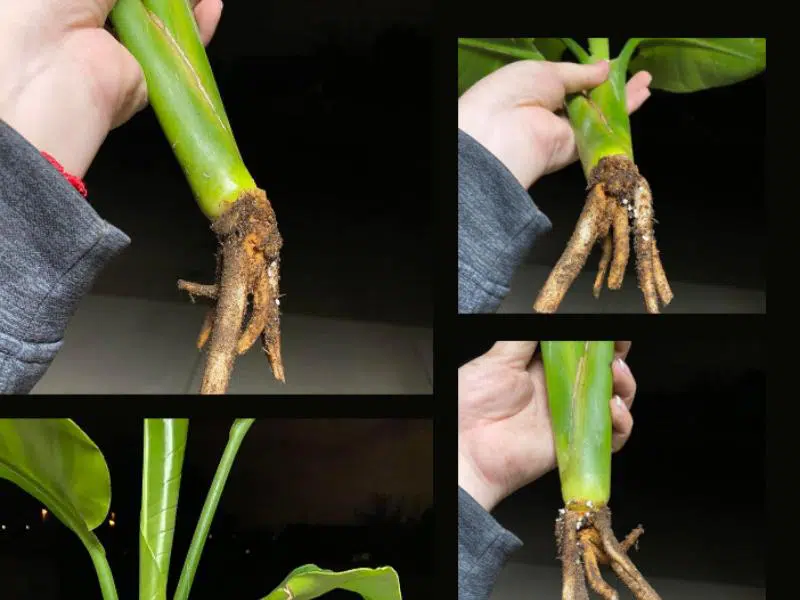
Immediately after diagnosing your bird of paradise with root rot, the next step is to treat it to prevent further spread to the other parts. The disease can kill the plant if not controlled. Here’s how to treat root rot in your bird of paradise plant.
1. Remove the damaged parts.
Using a pair of shears or scissors, cut damaged flowers, leaves, buds, and stems, leaving only the good parts.
2. Trim the damaged roots.
- Let the pot sit on its sides and loosen the soil around the plant using your fingers.
- Gently pull the plant, ensuring to remove the whole root system.
- Shake the soil around the root ball and wash the remaining with a hose. The roots should be free from dirt to help you spot the infected ones.
- Cut the infected roots using a sterile, sharp pair of shears or scissors. Damaged roots are dark brown or black and feel soft and smushy when touched. Sterilize the shears or scissors with rubbing alcohol after a few cuts to prevent fungi from spreading to the other parts.
- Air the plant to remove moisture.
3. Treat the plant with a copper-based fungicide
Dip the dry bird of paradise plant in a copper-based fungicide to kill any fungus on the roots.
4. Repot the plant
A fresh, sterile, nutrient-rich potting mix and a new container prevent the transfer of fungi into the new pot. The container should have enough holes underneath for good water drainage. Add some mulch or sand to the pot.
Dip the copper-base treated plant into the container with the potting mix.
5. Water the plant
Wet the mix sparingly in a watering can. The soil should not be overly wet as it can cause root rot again.
Bird paradise will root in six weeks. Continue watering. Always check the top 2-3 inches to know when to water next.
Common fungi that attack strelitzia plants
Many fungi species cause root rot in bird of paradise. Knowing the specific fungi causing root rot is vital for applying the best treatment.
The table below shows the most common root rot-causing- fungi in bird of paradise plants:
| Fungi | Signs | Best treatment |
| Phytophthora | Phytophthora is prone to overly wet soils and cold temperatures. Phytophthora root rot makes bird of paradise stems appear discolored and droopy | Copper-based fungicide |
| Fusarium solani | Fusarium is a soil-borne fungus that affects the Strelitzia plant’s roots and stems. It causes stunted growth, yellowing leaves, rotting roots, wilting, and death. | Move the plant to warmer locations to fix low-temperature issues. |
| Pythium | Pythium thrives in soggy soil and causes rotting in the roots and stems of infected plants. Pythium-infested parts become soft, mushy, and appear darker. The plants experience dieback and die if untreated. | Maintain well-drained soil and water correctly. |
| Armillaria | The fungus from the genus Armillaria causes brown or yellow foliages, undersized leaves, stunted growth, and plant death. Sometimes, mushrooms grow at the base of the Armillaria root rot infected plant. | Constant removal of affected parts. |
| Botrytis | This fungus is common in low temperatures and high humidity. Botrytis discolors the flowers and leaves. The leaves wilt, droop and die. | Prune spotted, dying, or rotten parts and improve air circulation. |
References:
[1] Clemson University Cooperative: Bird of Paradise.
[2] University of Minnesota Extension: Armillaria root rot.
